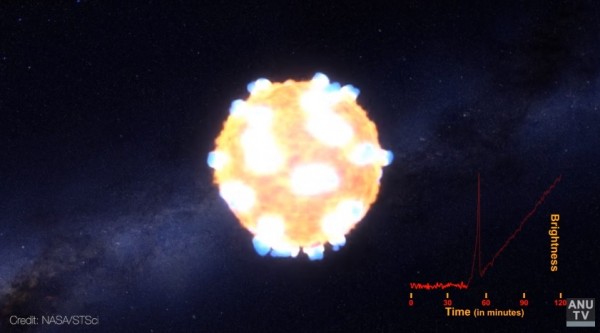By Ana Verayo, | March 22, 2016

Artist visualization of supernova star explosion emitting powerful shockwave.
For the first time ever, astronomers have captured moments before two stars begin to explode which resulted in the most powerful shockwave generated by the collapsing core of the star.
Researchers from the ANU Research School of Astronomy and Astrophysics discovered this supernova shock wave or this "shock breakout" inside the core of the larger supernova. This new finding can help shed more light about how dying star explosions can create elements in the universe, which are the building blocks of planets in the solar system, Earth and ultimately, the material that created humans as well.
Like Us on Facebook
According to Brad Tucker from the ANU Research School of Astronomy and Astrophysics, this is similar to a shockwave from a nuclear bomb, in a much larger scale where nobody gets hurt.
These supernovae are classified as Type II, which means that their internal stellar core finally runs out of hydrogen fuel, causing its insides to collapse where powerful gravitational forces devour the star. Since supernovae are so bright, they are observed even from distant galaxies, reaching Earth, that can help astronomers understand more about the inner workings of the universe. However, only little is known about the early stages of these powerful stellar explosions when stars die.
In this new study, scientists detail the explosions of two aging stars, specifically two red supergiants. When the core of a supernova collapses that will transform into a neutron star, as energy will be sucked in again back to the core, in the form of a shockwave that can travel 30,000 to 40,000 kilometers per second, generating a nuclear fusion and creating heavy elements like gold, silver and uranium.
The ANU team along with scientists from the the University of California Berkeley, University of Maryland, University of Notre Dame and the Space Telescope Science Institute observed this very shockwave from the smaller star known as KSN 2011a which is 270 times bigger than the sun, located some 700 million light years away. This shockwave is revealed as a bright light that was emitted from this explosion just a few days after.
The second larger supergiant known as KSN 2011d, is estimated to be 1.2 billion light years away, which is also 460 times larger than the sun. However, its shockwave has not been detected yet but astronomers believe that it exists. Tucker adds that this star was so massive that the shockwave did not travel all the way to the surface from the core.
With this new findings from data from NASA's Kepler Space Telescope, astronomers can produce new techniques in understanding how the size and composition of a star can affect the early stages of their death explosions.
Tucker says that the team has been studying the process of these explosions, as supernovae are responsible for making heavy elements that humans need to survive such as iron, zinc and iodine.
This new study is published in the Astrophysical Journal.
-
Use of Coronavirus Pandemic Drones Raises Privacy Concerns: Drones Spread Fear, Local Officials Say

-
Coronavirus Hampers The Delivery Of Lockheed Martin F-35 Stealth Fighters For 2020

-
Instagram Speeds Up Plans to Add Account Memorialization Feature Due to COVID-19 Deaths

-
NASA: Perseverance Plans to Bring 'Mars Rock' to Earth in 2031

-
600 Dead And 3,000 In The Hospital as Iranians Believed Drinking High-Concentrations of Alcohol Can Cure The Coronavirus

-
600 Dead And 3,000 In The Hospital as Iranians Believed Drinking High-Concentrations of Alcohol Can Cure The Coronavirus

-
COVID-19: Doctors, Nurses Use Virtual Reality to Learn New Skills in Treating Coronavirus Patients







